
5 minutes - magazine 01 | 2024
On behalf of science
Worldwide in lifting operations
From ancient turbines to the vastness of outer space - in action for extraordinary lifts
Every single one of our mobile cranes is designed to suit the requirements of our customers and markets. The technology in the machines differs depending on the size of the crane and the aim of the crane development process. In recent years, several of our cranes have also been used for extraordinary lifts. This can involve moving a turbine, removal of a telescope or setting up a radio telescope in the middle of the desert.
Since October 2015, the Deutsches Museum in Munich has been updating and redesigning its exhibitions. In the process, the historical building itself is also being brought up to the latest technical standard. Last year, the museum had to make room for a small container village in the courtyard in front of the original main entrance. Various large exhibits had to make way – including a historic impeller of a Francis turbine.
Over 80 years old, weighing 44 tonnes and measuring 4.6 metres in diameter – these are the turbine's key data. However, it was not the historical object, but the cramped conditions at the new position of the exhibit that challenged the crane drivers: “In addition to the partly sloping museum garden, the traffic conditions in Munich are not easy – narrow bridges and narrow streets filled with parked cars required special skill. But thanks to the compactness and active rear axle steering of the LTM 1250-5.1, that wasn’t a problem either,” reports Susanne Maier, Managing Director of Kran-Maier from Landshut. In a convoy with escort vehicles and police escort, the historic impeller arrived at its destination within a very short time.
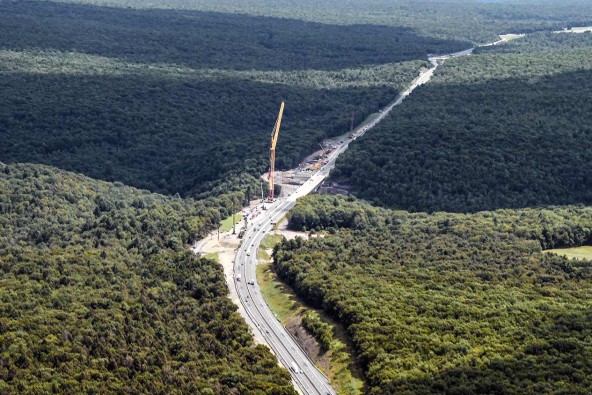
A Liebherr LTM 1250-5.1 mobile crane from Kran-Maier lifts the 44-tonne impeller out of the courtyard of the Deutsches Museum in Munich.
The impeller in the Deutsches Museum was produced in 1939 by Heidenheim-based J. M. Voith GmbH and was part of a turbine for a river power station on the Sungari River in the Chinese region of Manchuria. However, due to the start of the Second World War, the impeller was not delivered – it would have passed 8820 cubic metres of water at a drop height of 69 metres and a frequency of 125 revolutions per minute, thus achieving an output of 85 MW.
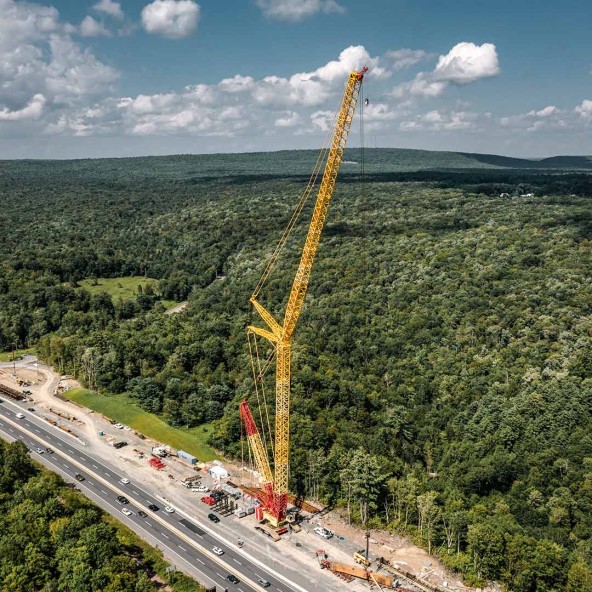
A composite image of the future SKA telescopes combining an artist’s impression with the elements already present on site. From left to right: the future SKA-Mid dishes blend into the existing dishes of the MeerKAT precursor telescope in South Africa, and antennas from the existing SKA-Low prototype station AAVS2 blend into the future SKA Low stations in Australia. Credit: SKAO
The SKA telescopes are set to become two of the largest and most sensitive radio telescopes of the next 50 years. The SKA project has been on the roadmap of the European Strategy Forum on Research Infrastructures since 2006 and has been recognised as a key institution for European research in astronomy.
Back to the future: Mapping the universe

The LTM 1220-5.2 assembling the SKA MPG prototype antenna in the Karoo, South Africa. Image: Nasief Manie / SARAO
A scientific endeavour on a gigantic scale is underway involving governments and institutions on five continents, who are working together to build the SKA radio telescopes. SKA stands for Square Kilometre Array, and these two complementary, world-class instruments will revolutionise our understanding of the Universe. By the end of the 2020s, the SKA Observatory (SKAO) will have built 197 parabolic dishes in South Africa and 131,072 smaller antennas in Western Australia. These will be interconnected via sophisticated computer networks. The telescopes will collect radio waves from space to create the largest cosmic atlas to date and gain insights into the formation and development of the first stars and galaxies after the Big Bang, among a myriad of science goals.
Two remote locations were selected for the telescopes: the Karoo region in South Africa and the Murchison Shire in Western Australia, which benefit from protected radio quiet zones, essential for radio astronomy. In spring 2019, the South African Radio Astronomy Observatory (SARAO), together with the Max Planck Society (MPG) – both partners of the SKAO – built the first on-site prototype for the telescope in South Africa. The parabolic antenna bears the official designation SKA-MPG telescope and has a diameter of 15 metres. The South African company CC Crane Hire was commissioned to erect the antenna with a height of 22 metres using an LTM 1220-5.2. The 5-axle vehicle has a 60-metre main boom and a maximum lifting capacity of 220 tonnes – enough power to erect a state-of-the-art telescope.
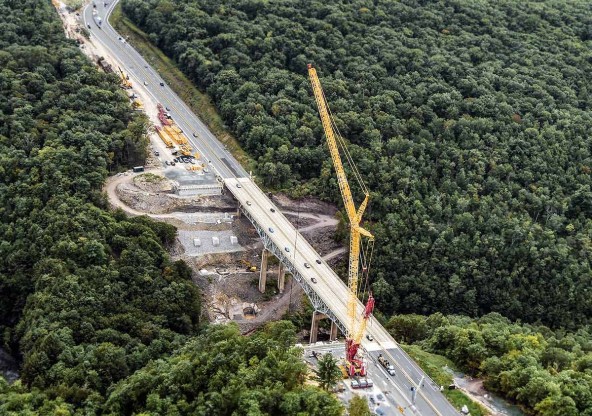
Made to measure – Museum staff align the telescope with centimetre precision so that it can be lifted out through the slit gate of the East Observatory.
From the observatory to the depot
Back to the Deutsches Museum in Munich: Two years ago in autumn, the Goerz reflector, a two-tonne telescope from 1913, floated through the air on the hook of an MK 88. Like all mobile construction crane models from the Liebherr plant in Biberach, this MK combines the functional advantages of a tower crane with the mobility of a classic mobile crane. With the manoeuvrable chassis, which is manufactured in Ehingen, the taxi crane requires very little space – whether during assembly or in operation.
The extensive refurbishment of the museum was also the reason for lifting the reflecting telescope. “With a hook height of 41 metres and equipped with 1.5 tonnes of ballast, the MK 88 had to lift the telescope out of the dome from a distance of 39 metres,” recalls Matthias Bulisch, Branch Manager of Treffler in Munich. In addition to a great deal of dexterity during the lift, the positioning of the crane was also no mean feat: due to the fact that the courtyard has a basement, a suitable load-bearing site had to be found in the museum courtyard.
The reason for lifting the reflecting telescope was also the extensive refurbishment of the museum. In October 2022, the second part of the exhibition building, which also includes the eastern observatory, was cleared out. The telescope was moved to the depot to protect it from construction site dust and potential vibrations that would interfere with the sensitive optics. While it is in storage, the museum staff are using the time to renew the coating on the mirrors – maintenance that is required on a regular basis.
It will be 2028 before visitors to the observatory have another opportunity to look through the telescope into the vastness of space. By then the museum will celebrate its 125th anniversary and the refurbishment will be complete. Perhaps a Liebherr crane will be used again until then.
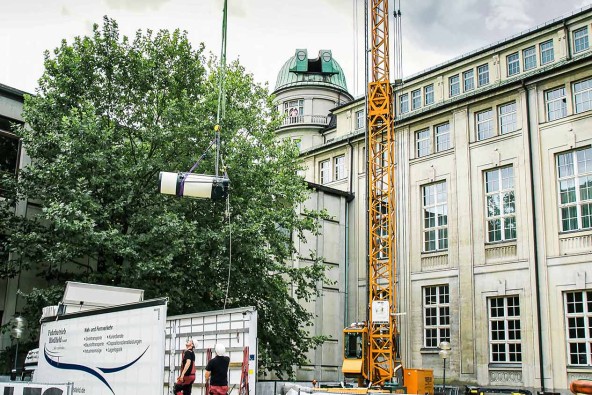
The Treffler MK 88 carefully lifts the Goerz telescope from the observatory of the Deutsches Museum into the transport vehicle. Image: Bernhard Thaler
The telescope from Berlin-based company Goerz was originally designed for an expedition by the observatory of the Königlich Technische Hochschule Berlin and Goerz. The occasion: the observation of the total solar eclipse on 21 August 1914 in Sandnessøen on the Norwegian island of Alsta. However, the expedition was cancelled due to the outbreak of the First World War. Since the opening of the Deutsches Museum on Museum Island in 1925, the Goerz telescope has been the main instrument in the Deutsches Museum’s East Observatory.
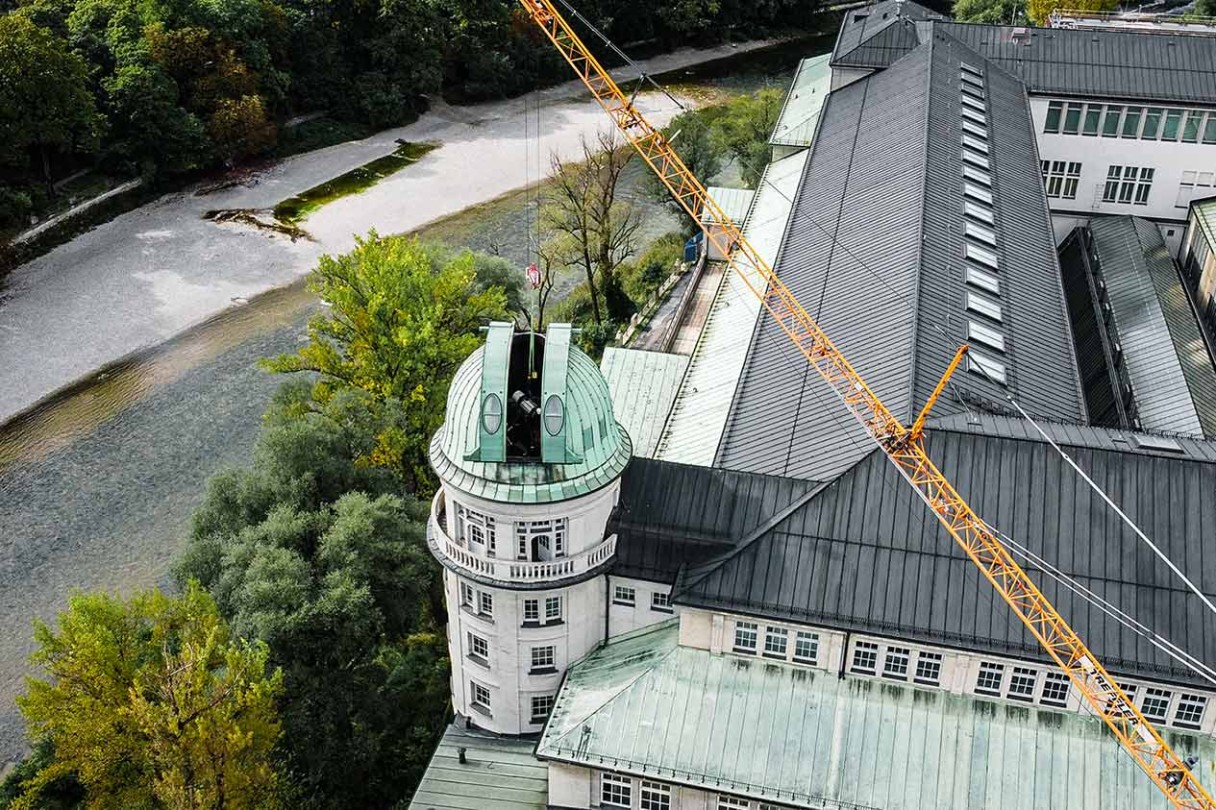
Image: Marco Sproviero
This article was published in the UpLoad magazine 01 | 2024.



